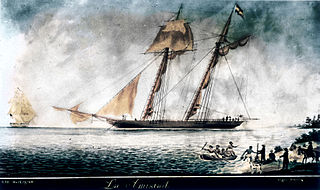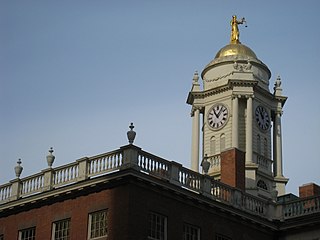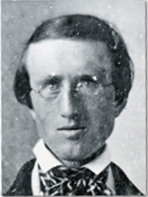
Hartford is the capital city of the U.S. state of Connecticut. The city, located in Hartford County, had a population of 121,054 as of the 2020 census. Hartford is the most populous city in the Capitol Planning Region and the core city of the Greater Hartford metropolitan area.

Harriet Elisabeth Beecher Stowe was an American author and abolitionist. She came from the religious Beecher family and wrote the popular novel Uncle Tom's Cabin (1852), which depicts the harsh conditions experienced by enslaved African Americans. The book reached an audience of millions as a novel and play, and became influential in the United States and in Great Britain, energizing anti-slavery forces in the American North, while provoking widespread anger in the South. Stowe wrote 30 books, including novels, three travel memoirs, and collections of articles and letters. She was influential both for her writings as well as for her public stances and debates on social issues of the day.

Catharine Esther Beecher was an American educator known for her forthright opinions on female education as well as her vehement support of the many benefits of the incorporation of kindergarten into children's education. She published the advice manual The American Woman's Home with her sister Harriet Beecher Stowe in 1869. Some sources spell her first name as "Catherine".

James William Charles Pennington was an American historian, abolitionist, orator, minister, writer, and social organizer. Pennington is the first known Black student to attend Yale University. He was ordained as a minister in the Congregational Church, later also serving in Presbyterian churches for congregations in Hartford, Connecticut, and New York. After the Civil War, he served congregations in Natchez, Mississippi, Portland, Maine, and Jacksonville, Florida.

Isabella Beecher Hooker was a leader, lecturer and social activist in the American suffragist movement.

La Amistad was a 19th-century two-masted schooner owned by a Spaniard living in Cuba. It became renowned in July 1839 for a slave revolt by Mende captives who had been captured and sold to European slave traders and illegally transported by a Portuguese ship from West Africa to Cuba, in violation of European treaties against the Atlantic slave trade. Spanish plantation owners Don José Ruiz and Don Pedro Montes bought 53 captives in Havana, Cuba, including four children, and were transporting them on the ship to their plantations near Puerto Príncipe. The revolt began after the schooner's cook jokingly told the slaves that they were to be "killed, salted, and cooked." Sengbe Pieh unshackled himself and the others on the third day and started the revolt. They took control of the ship, killing the captain and the cook. Two Africans were also killed in the melee.

The Harriet Beecher Stowe House is a historic home in Cincinnati, Ohio which was once the residence of influential antislavery author Harriet Beecher Stowe, author of the 1852 novel Uncle Tom's Cabin.

The History of Hartford, Connecticut has occupied a central place in Connecticut's history from the state's origins to the present, as well as the greater history of the United States of America.

Olivia Langdon Clemens was the wife of the American author Samuel Langhorne Clemens, better known under his pen name Mark Twain.

The Harriet Beecher Stowe House is a historic house museum and National Historic Landmark at 73 Forest Street in Hartford, Connecticut that was once the home of Harriet Beecher Stowe, author of the 1852 novel Uncle Tom's Cabin. Stowe lived in this house for the last 23 years of her life. It was her family's second home in Hartford. The 5,000 sq ft cottage-style house is located adjacent to the Mark Twain House and is open to the public. It was listed on the National Register of Historic Places in 1970, and declared a National Historic Landmark in 2013.

Originating in New England, one particular Beecher family in the 19th century was a political family notable for issues of religion, civil rights, and social reform. Notable members of the family include clergy, educators, authors and artists. Many of the family were Yale-educated and advocated for abolitionism, temperance, and women's rights. Some of the family provided material or ideological support to the Union in the American Civil War. The family is of English descent.

The First Church of Christ, Congregational, also known as First Church 1652 is a historic church at 75 Main Street in Farmington, Connecticut. Built in 1771, this Greek Revival church was designated a National Historic Landmark in 1975 for its role in sheltering the Amistad Africans before their return to Africa.

Rev. Joshua Leavitt was an American Congregationalist minister and former lawyer who became a prominent writer, editor and publisher of abolitionist literature. He was also a spokesman for the Liberty Party and a prominent campaigner for cheap postage. Leavitt served as editor of The Emancipator, The New York Independent, The New York Evangelist, and other periodicals. He was the first secretary of the American Temperance Society and co-founder of the New York City Anti-Slavery Society.

Calvin Ellis Stowe was an American Biblical scholar who helped spread public education in the United States. Over his career, he was a professor of languages and Biblical and sacred literature at Andover Theological Seminary, Dartmouth College, Lane Theological Seminary, and Bowdoin College. He was the husband and literary agent of Harriet Beecher Stowe, author of the best-seller Uncle Tom's Cabin.

The Katharine Seymour Day House is a historic house at 77 Forest Street in the historic Nook Farm district of Hartford, Connecticut. Built in 1884 for a local businessman seeking to compete stylistically with the adjacent Mark Twain House, it is a good local example of Queen Anne architecture. It now serves as the administrative center and library for the Harriet Beecher Stowe Center. It was listed on the National Register of Historic Places in 1971.

The house at 36 Forest Street, sometimes called the Burton House in Hartford, Connecticut, United States, is a wooden Shingle Style structure built in the late 19th century and largely intact today. It was listed on the National Register of Historic Places in 1983.
Katharine Seymour Day was an American preservationist from Hartford, Connecticut. She worked as a member of the Hartford City Planning Commission to preserve historic homes in Connecticut and helped establish the Children’s Museum of Hartford and the home of Mark Twain as a memorial. She served as president of the Mark Twain Library and Memorial Commission. She was inducted into the Connecticut Women's Hall of Fame in 1994. The Katharine Seymour Day House has been preserved as part of the Harriet Beecher Stowe House Museum.

Nook Farm is a historical neighborhood in the Asylum Hill section on the western edge of Hartford, Connecticut, USA.

James Chaplin Beecher, was an American Congregationalist minister and Colonel for the Union Army during the American Civil War. He came from the Beecher family, a prominent 19th century American religious family.

The John and Isabella Hooker House is a historic house at 140 Hawthorn Street in Hartford, Connecticut. Built in the 1850s and twice enlarged, it is a distinctive and large example of Italianate country villa architecture. It was listed on the National Register of Historic Places in 1979.




















